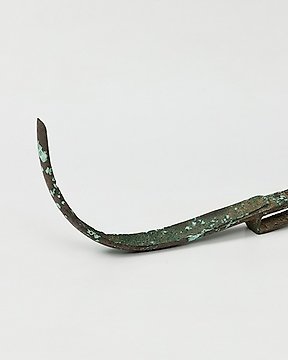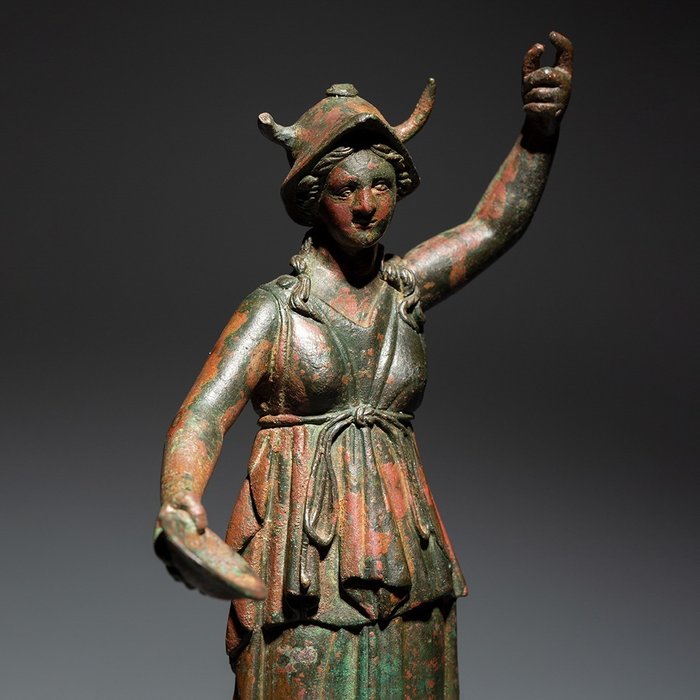
Roma antica Bronzo Strigil - Con licenza di esportazione spagnola - 19×2×1.5 cm - (1)
N. 69843871

N. 69843871

Statue of goddess Minerva
Roman Empire, 1st to 2nd Century BC
MATERIAL: Bronze
DIMENSIONS: Height 18.5 cm without stand. With stand 25 cm H.
PROVENANCE:
Private collection, Japan, formed in the 1960s.
Galería Archaique, Japan, before 1997.
Private collection S. A., London.
PUBLICATIONS: - Christie's. Antiquities. London. 6 December 2017. Lot 66.
CONDITION: In a good state of preservation. Without restoration. There is damage to the tip of the index finger of the left hand and to the point of the horm on the right of the helmet.
DOCUMENTS: Search Certificate for David Aaron LTD.
DESCRIPTION:
A powerful sculptural image of the goddess Athena worked in bronze by the lost-wax technique. Two of the rods or pins that allowed the piece to be fixed in a support or base can be seen protruding from the bottom of the gown. The base would have been worked separately. The possibility that this piece was an appliqué to be attached to some piece of furniture with these rods, should not, however, be discounted. It could also have been placed in a private lararium as a sculpture for the private worship of the goddess.
The dimensions of the figure are considerable in relation to the small ex-votos which are preserved with the image of Minerva, the Athena of the Greek world. The attire and attributes of this representation allow us to make out the identity of the goddess. She is wearing a Doric peplum which falls vertically but is gathered to form a big fold at the level of the hips. This is gathered below the breasts in the centre by a tied cord forming a large hanging bow.
Between her legs the peplum forms a thick and prominent fold which becomes the central element of the composition. In all the minutiae of her attire, and the piece in its entirety, carefully worked as a free-standing piece, the delicacy and outstanding quality of the modelling can be observed, as well as the special attention to detail. This is not very common in the series of votive statues that are known of from the entire Empire, most of which received shorter attention in their elaboration.
The figure is composed resting on the left leg as an element of support, although the volume of the leg can hardly be noted under the garment. The right leg can be noted slightly under the folds. The torso seems slightly turned to the right, an effect which is emphasized by the position of the head, held high and turned to this side. The precise modelling of the rounded oval of the face and the delicacy with which the other facial features have been worked, warrant special attention. We observe soft features and may sense a smile.
She is usually depicted with a serene but striking face. This statuette, however, shows a more youthful and human side of Minerva, because in this case she is not represented with her war attributes, such as the shield, aegis or feathered Corinthian helmet. Instead, she is crowned by an Attic helmet with horns, used in a similar way. These decorative helmets were more ceremonial objects than functional ones. Side locks protrude below the front of the helmet, and long hairs is divided in two large contoured braids which are joined on its back, below the end of the crest extending over the helmet.
For its typology the piece represents the theme of a divinity making an offering. In her right hand, which is extended outward towards the viewer, the goddess holds a phiale or patera with a central indentation, the omphalos. This is a shallow libation bowl, which forms part of the ritual religious art of ancient Greece. The left arm, raised above the head with a semi-open hand, clearly indicates the posture of holding a spear (Fig. 1). It is one of the combinations (with the exception of the horned helmet) in which the goddess has most frequently been depicted in ex-votos (Fig. 2), much smaller than the one shown here, but with the more common helmet of the type of the Athena Piraeus (Fig. 3).
The quality of this work allows us to bring it close to the best pieces of small toreutic working which came out of the Romano-Oriental workshops where these statuettes were made, starting from reinterpretations or variants which, in general composition or in the details and concrete attributes, refer to those originals.
In Roman mythology Minerva is the goddess of wisdom, the arts, the art of war, as well as being the protector of Rome and the patroness of craftsmen. She corresponds to Athena in Greek mythology. For the Greeks she is the goddess of war, civilization, knowledge, strategy, the sciences, justice and skill. She is one of the principal divinities in the Greek pantheon and one of the twelve Olympic gods. Athena was worshipped throughout the entire Ancient Greek world and all of its areas of influence, from the Greek colonies in Asia Minor to the Iberian Peninsula and the north of Africa. Her presence has also been confirmed even in the vicinity of India. For this reason her cult took on many forms and even had considerable presence, to the point that her figure was synthesized with other divinities in nearby regions on the Mediterranean.
She was one of the most represented deities in Greek art and her symbology had a profound influence on the thinking in that culture, especially concerning concepts related to justice, wisdom and the social function of culture and the arts. This is still reflected and can be seen right down to our present time in the entire western world. Her image underwent various transformations over the centuries, incorporating new attributes, interacting with new concepts, and influencing other symbolic figures. It was used by various political regimes to give legitimacy to their principles. It even influenced popular culture: her intriguing identity has given special support to writers linked to feminist movements, as well as anti-feminist movements, to psychology and even some contemporary religious movements have returned to worship her.
Minerva, Jupiter, and Juno were particularly worshipped in Ancient Roman regions as they formed the Capitoline Triad. They were honoured in temples built on hills, adorned with statues or reliefs bearing the effigy of the trio. However, the Romans favoured the belligerent side of Minerva and most of the representations of the goddess of warfare in religious rituals are found in Ancient Greece art, especially pottery.
The lararium (Fig. 4) was a small shrine in Roman houses in which the family members could place offerings on an altar and offer up prayers to the household gods. These were represented by statuettes called lares, mostly made of bronze. In patrician residences the lararium was in general found in the atrium, the central hall of the residence. In a simpler residence without an atrium, the shrine would be in the kitchen near the central fire.
The technique of lost wax casting is a sculptural procedure using a mould made from a prototype of the piece to be worked, and this prototype is usually made from beeswax. This is covered with a thick layer of soft material, usually clay, which then solidifies. Once this has hardened it is put in a kiln where the wax inside melts and leaks out from expressly made holes in the clay. In its place molten metal is injected and this takes on the exact form of the mould. To extract the final piece the mould must be removed.
BIBLIOGRAPHY:
- Manifestaciones religiosas privadas. Los bronces romanos en Hispania. Madrid. 1990. pp. 231 – 252.
- BOUCHER, S. Recherches sur les bronzes figurés de Gaule pré-romane et romane. Paris. 1976.
PARALLELS:
Fig. 1 Athena with a phiale and spear. Al fresco painting. 1st – 2nd century AD. Private collection.
Fig. 2 Minerva in a pose of holding phiale and spear. Bronze. 1st – 2nd century AD. Height 10 cm. Museum of the Temple of Augustus, Pula.
Fig. 3 Athena Piraeus. Bronze4th century BC. Height 235 cm. Museum of Archaeology, Piraeus.
Fig. 4 Lararium in the Casa de los Vetti. Pompeii.
Notes:
M.E.
The seller guarantees that he acquired this piece according to all national and international laws related to the ownership of cultural property. Provenance statement seen by Catawiki.
The seller will take care that any necessary permits, like an export license will be arranged, he will inform the buyer about the status of it if this takes more than a few days.
The piece includes authenticity certificate.
The piece includes Spanish Export License (Passport for European Union) - If the piece is destined outside the European Union a substitution of the export permit should be requested.
Come fare acquisti su Catawiki
1. Scopri oggetti speciali
2. Fai l’offerta più alta
3. Paga in tutta sicurezza